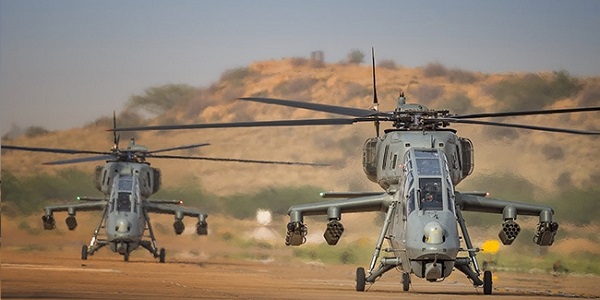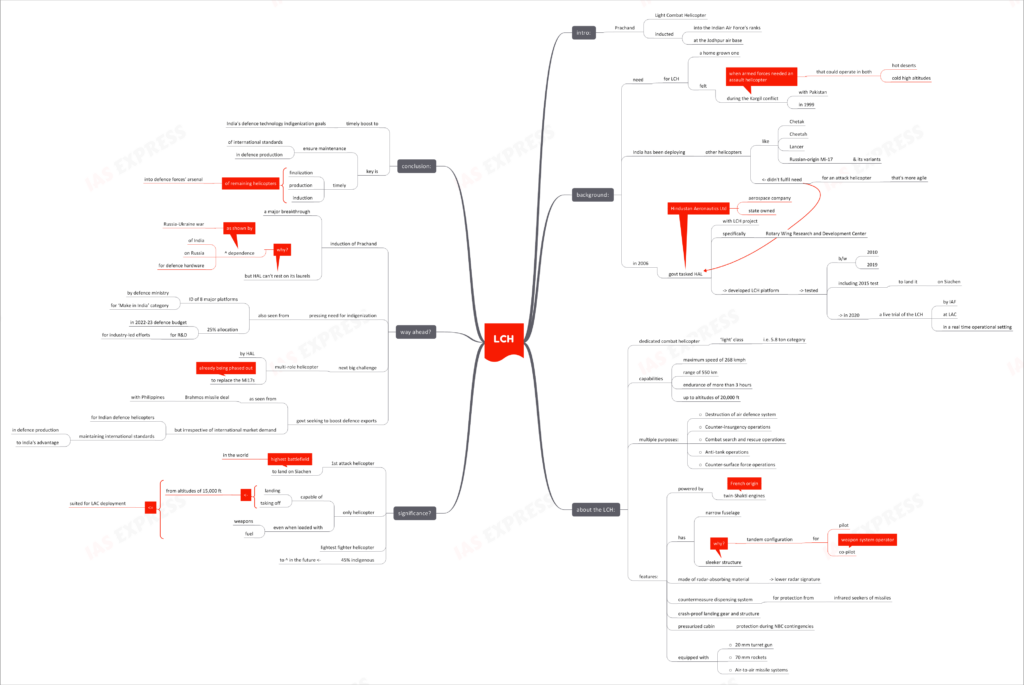Light Combat Helicopter: Features and Significance

In a timely boost to India’s defence technology indigenization goals, ‘Prachand’ the Light Combat Helicopter was inducted into the Indian Air Force’s ranks at the Jodhpur air base.

This topic of “Light Combat Helicopter: Features and Significance” is important from the perspective of the UPSC IAS Examination, which falls under General Studies Portion.
Background:
- The need for a home-grown light combat helicopter was felt during the Kargil conflict with Pakistan in 1999. The armed forces required an assault helicopter that could operate in hot deserts as well as cold high altitudes.
- Over the years, India has been deploying other helicopters like the Chetak, the Cheetah and the Lancer, in addition to the Russian-origin Mi-17 and its variants. However, these didn’t fulfil the need for a multi-role attack helicopter that is more agile.
- The government tasked HAL (Hindustan Aeronautics Ltd.) with the LCH project in 2006. The state-owned aerospace company’s Rotary Wing Research and Development Center took up this project.
- After the platform was developed, it was subject to several tests, including a 2015 test of its landing abilities at Siachen, between 2010 and 2019.
- In 2020, the IAF conducted a live trial of the LCH in a real time operational setting, at the LAC.
About the helicopter:
- The LCH is a dedicated combat helicopter of the ‘light’ class i.e. 5.8 ton category.
- It has a maximum speed of 268 kmph, a range of 550 km and an endurance of more than 3 hours. It can operate up to altitudes of 20,000 ft.
- It has multiple purposes:
- Destruction of air defence system
- Counter-insurgency operations
- Combat search and rescue operations
- Anti-tank operations
- Counter-surface force operations
- It is powered by twin engines- French-origin Shakti engines.
- It has a narrow fuselage and sleeker structure as it features tandem configuration (i.e. one behind the other arrangement) for the pilot and the co-pilot. The co-pilot is the weapon system operator.
- It is made of radar-absorbing material, enabling a lower radar signature. It has a countermeasure dispensing system for protection from the infrared seekers of missiles.
- It is equipped with several weapons:
- 20 mm turret gun
- 70 mm rockets
- Air-to-air missile systems
- It also has a crash-proof landing gear and structure.
- Its pressurized cabin enables protection during NBC (nuclear, biological and chemical) contingencies.
Why is it significant?
- The LCH became the 1st attack helicopter to land on Siachen- the highest battlefield in the world.
- It is the only helicopter capable of landing and taking off, even when loaded with weapons and fuel, from altitudes of 15,000 ft. This makes it suited for deployment along the LAC.
- It is considered as the lightest fighter helicopter in the world.
- It is currently 45% indigenous, but is expected to become even more indigenous in the future.
- The induction of the LCH is a major achievement, given how slowly the defence procurement bureaucracy operates.
What is the way ahead?
- Though the induction of Prachand is a major breakthrough, the HAL hasn’t the time to rest on its laurels.
- The Russia-Ukraine War has highlighted the degree of India’s dependence on Russia for its defence hardware.
- There is a pressing need for indigenization of defence hardware. Earlier this year, the Defence Ministry identified 18 platforms for ‘Make in India’ category. The 2022-23 defence budget has allocated 25% of the research and development for industry-led efforts in this direction.
- The next big challenge is the multi-role helicopter being developed by HAL to replace the Mi17s (already being phased out).
- The government has also been boost its defence exports. For instance, India has successfully pitched the Brahmos missile to Philippines. Irrespective of the international market demand for Indian defence helicopters, maintaining international standards in defence production stands to India’s advantage.
Conclusion:
The induction of LCH into the air force’s ranks is a major breakthrough in India’s indigenization push in the defence hardware sector. The key is to ensure maintenance of international standards in defence production and timely finalization, production and induction of the remaining helicopters into the defence forces’ arsenal.
Practice Question for Mains:
What are the features of the LCH? Discuss the significance of this indigenously manufactured helicopter. (250 words)

